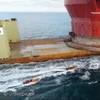Non-tank Vessel Response Rules – Their Impact Examined
Long awaited, much hyped, the new rules require compliance in January. Will industry and more importantly, the response community, be ready?
In September, the U.S. Coast Guard published the long awaited Non-tank Vessel Response Plan (NTVRP) and Other Response Plan regulations. The U.S. Coast Guard cites “Improved preparedness and reaction to an incident, including a worst case discharge, and improved effectiveness of shore-side and onboard response activities” as the primary benefits of the new rule. For all affected vessels, a mandatory compliance date of January 30, 2014 looms large the porthole. The regulations impact self-propelled non-tank vessels of 400 gross tons or greater that operate in navigable waters of the United States and carry any kind of oil as fuel for main propulsion. It is noteworthy that the NTVRP requirements for planning of response services are scaled to oil carrying capacity. Hence, small non-tank vessels with less oil carrying capacities will have fewer functional planning requirements.
The new rule also stipulates that non-tank vessel owners operating in and out of U.S. waters enter into agreements with a Salvage and Marine Firefighting (SMFF) provider and list predefined response resources in the VRP. As many as 14,000 vessels will ultimately be required to comply with the SMFF requirements. The Coast Guard itself says that the NTVRP final rule will impact an estimated 12,000+ nontank vessel users, with foreign-flag vessels comprising the majority of the vessels affected. While the costs of the rules are spread between U.S. and foreign nontank vessels, approximately 40 percent of this final rule’s $263 million 10-year cost will ultimately be borne by domestic vessel owners/operators.
Like any other Coast Guard rulemaking effort, questions remain unanswered as stakeholders from all sides of the equation ramp up for increased business, the cost of yet another regulatory burden and the hassle of ensuring compliance. That said; a visit with Lindsay Malen, Director of Business Development at TITAN Salvage and the Marine Response Alliance (MRA) shed additional light onto what is coming, what’s already in place, and why you should care.
Capacity and Wherewithal
Non-tank vessel owners are required to submit their Vessel Response Plan to the Coast Guard by January 30, 2014. That much is cut and dried. Looking ahead to see if the response community itself is ready is another thing altogether. According to MRA’s Malen, the new rules primarily signal a sea change in terms of how operators do business. “I think that we have been prepared for a long time for the actual volume of business. The MRA has been listed in NON TANK VRPs for the past 20 years and it is just that now the USCG is actually enforcing this regulation and making non tank operators have a contracted Funding Agreement in place. This will mean more paperwork for everyone, the owner/operator, the QI, the SMFF and especially the USCG.” According to Malen, then, the tank regulations were a test drive but now, the rules simply involve many different classes of vessels from mega yachts to container vessels. Nevertheless, she adds, “There are five SMFF providers who have been thoroughly vetted by the USCG to adhere to their requirements to qualify as an SMFF. In truth, the U.S. is a very safe place to trade and we do not often see incidents here.”
Funding & Agreements: Guarantees & Changes
As non-tank vessel owners are required to enter into funding agreements with salvors and marine fire-fighting resources, it will be the fine print of those documents that matter most. According to Malen, the bottom line is relatively simple and not necessarily burdensome for cash-strapped operators. “The Funding Agreement is actually a facet to ensure that we as SMFF respond to an incident with no delay in negotiating a contract as that contract (the Funding Agreement) is already in place. The owners must list a provider, but depending on the provider, the cost is relatively low.” She adds, “It is more of the time and task as well as cost of vetting the SMFF provider, which is the owner’s responsibility.”
For the typical nontank vessel operators, some things will change and others will remain unchanged. For example, as operators choose the SMFF provider, they will also have to vet the provider. Unlike OSRO’s, which are classified by the Coast Guard, it is the responsibility of the shipowner to verify that the salvor and firefighter have capabilities measured against 15 criteria listed in Annex 2 of the rules. But, this will allow them an opportunity to truly engage their salvor, something which is not usually done. MRA’s Malen says, “This is a pro-active approach that I think is beneficial to the entire industry. The owner/operators will also have to exercise various drill requirements with their QIs, SMFFs, OSROs, and even random drills with the USCG.” From the regulatory side, vessel response plan particulars are now more likely to be enforced.
From MRA’s perspective, a proactive approach with clients includes in-house drills and training, as well as additional training through their lightering partner, Marine Pollution Control. At their Red Anchor training school, operators can take advantage of various training courses such as OSHA 1910.120 HAZWOPER Courses, Equipment Deployment (Booming, Recovery Techniques, etc.), Incident Command System Training, confined space entry and other customized programs that can also be brought to the owner/operators facilities. Malen emphasizes the point by saying, “This is a great advantage, as you would rather see how your salvors work in a drill situation rather than getting to know how they work during an actual incident. Again the owner/operator is engaging with the salvor.”
Technology, too
MRA/TITAN has also developed an exclusive App – the OPA 90 SMFF app – which will allow owner/operators to make emergency requests, reports, and request drills. This app will also give the owner/operator, QI, and USCG secure access to the Pre Fire Plans and Certificates as well as any other vessel documents they need to store. It is a requirement of the USCG to be able to access Pre Fire Plans on line, and now, MRA provides the service in a mobile application. The App’s utility goes far beyond the technology, says Malen. “We see it as not only a convenience that saves time and money, but a great tool. Our salvors can utilize it to download the client’s vessel documents on the way to a response and have these documents on their device off line, making the response more efficient.”
Risked Based & Scaled
The Federal Water Pollution Control Act defines a nontank vessel as a self-propelled vessel of 400 gross tons or greater that operates on U.S. navigable waters while carrying oil of any kind as fuel for main propulsion. Beyond this, the NTVRP requirements for planning response services are scaled to oil carrying capacity. Thus, for small non-tank vessels with less oil carrying capacities, there are fewer functional planning requirements.
Responders, Providers & Requirements
All of the vetted and approved SMFF providers – the final 5 – must have GSA Geographic Specific Appendices that adhere to the USCG time requirements for response resources and personnel. These GSAs are audited every quarter. Lindsay Malen told MarineNews in November that, “The MRA owns a majority of the assets listed in our GSAs, with Crowley and McAllister alone, we own over 150 US flagged tugs. We then also have our secondary MOUs or agreements with response resources. The owner/operators have access to our GSAs and we must cover all COPT zones.”
As compliance day approaches, many if not most nontank operators are well on their way to achieving compliance, but the journey still requires help. And, there is a lot of it out there. National Response Corporation (NRC) and RESOLVE Marine Group recently announced the expansion of their 1Call response coverage for all vessels trading in U.S. waters. The service offers tanker and nontank vessel owners and operators full, single-source coverage in compliance with latest U.S. Coast Guard regulations for Salvage and Marine Firefighting (SMFF), and Oil Spill Removal Organization (OSRO). In operation since 2003, the service offers comprehensive response coverage to international fleets as well as individual ship owners and operators, who trade in the U.S. According to RESOLVE Marine’s Joe Farrell, by providing a single point-of-contact for all required response services, 1Call streamlines compliance, response planning, and associated administrative processes while controlling costs. Farrell, President of RESOLVE Marine Group, said in October, “Since this relationship has been such a great experience, it only made sense to extend our 1Call service to all vessels.”
1Call team assets include response resources such as oil spill response vessels, aircraft, ocean going tugs, and oil recovery and salvage barges, and a national network of depots with equipment pre-staged to meet planning requirements that provide the best response capability. Steve Candito, President & CEO of National Response Corporation added, “We’ve had our 1Call response network in place for the past 10 years and are pleased to expand this service to all vessels in light of the USCG’s release of Nontank Vessel Regulations.”
The Salvage and Marine Firefighting (SMFF) core Geographic Specific Appendices (GSAs) voluntarily submitted to the Coast Guard for review by SMFF resource providers are conditionally accepted as listed below:
For its part, the Marine Response Alliance was formed in 1994 with the guiding principal (among others) of bringing member owned equipment and top emergency responders to offer OPA 90 Salvage Marine Fire Fighting services. Malen explains, “That is all that the MRA does; we live and breathe OPA 90. It is a bonus for us at TITAN as we are a global Lloyd’s listed super salvor and we can then offer our owner operators access to our services on a global basis with offices/depots in the UK, Singapore, Australia, and the largest Salvage depot in North America.”
The long awaited Non-tank Vessel Response Plan (NTVRP) regulations are (almost) here. Who you turn to for compliance is your business. On 30 January of next year, it will also be the business of the United States Coast Guard. For domestic operators – a key audience of MarineNews – the rules come at a collective cost of more than $100 million. Those entities providing response services will be the initial beneficiaries of at least some of that money, but in the long run, the environment will be the real winner. That’s a goal everyone – regulators, responders and nontank operators – can embrace.
(As published in the December 2013 edition of Marine News - www.marinelink.com)













